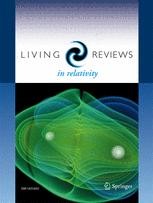Living Reviews in Relativity: Kilonovae by Brian D. Metzger
 Metzger, Brian D., Kilonovae, Living Rev Relativ (2017) 20: 3. doi:10.1007/s41114-017-0006-z
Metzger, Brian D., Kilonovae, Living Rev Relativ (2017) 20: 3. doi:10.1007/s41114-017-0006-z
Open Access | Review Article
First Online: 16 May 2017
Abstract:
The mergers of double neutron star (NS–NS) and black hole (BH)–NS binaries are promising gravitational wave (GW) sources for Advanced LIGO and future GW detectors. The neutron-rich ejecta from such merger events undergoes rapid neutron capture (r-process) nucleosynthesis, enriching our Galaxy with rare heavy elements like gold and platinum. The radioactive decay of these unstable nuclei also powers a rapidly evolving, supernova-like transient known as a “kilonova” (also known as “macronova”). Kilonovae are an approximately isotropic electromagnetic counterpart to the GW signal, which also provides a unique and direct probe of an important, if not dominant, r-process site. I review the history and physics of kilonovae, leading to the current paradigm of week-long emission with a spectral peak at near-infrared wavelengths. Using a simple light curve model to illustrate the basic physics, I introduce potentially important variations on this canonical picture, including: ∼day-long optical (“blue”) emission from lanthanide-free components of the ejecta; ∼hour-long precursor UV/blue emission, powered by the decay of free neutrons in the outermost ejecta layers; and enhanced emission due to energy input from a long-lived central engine, such as an accreting BH or millisecond magnetar. I assess the prospects of kilonova detection following future GW detections of NS–NS/BH–NS mergers in light of the recent follow-up campaign of the LIGO binary BH–BH mergers.
